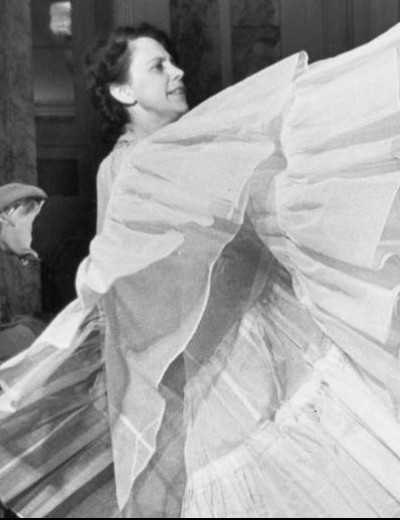
Emily Wilkens
About
Born in Hartford in 1917, Ms. Wilkens studied fashion illustration at Pratt Institute. After graduating in 1938, she began sketching dresses for department store newspaper advertisements. She married Judge Irving L. Levey in 1947.
Ms. Wilkens's sensibility ran toward the unconstricted; even her party dresses were made of washable cottons. With developing adolescent figures in mind, her dresses featured adjustable waistlines; her full skirts allowed for widening hips.
Ms. Wilkens came to the world of children's wear rather by accident. While vacationing in Hollywood in the early 1940's, Ms. Wilkens, then an illustrator, was erroneously introduced at a party as a children's fashion designer. Soon after, she was asked to design a wardrobe for Ann Todd, a child star, who needed to be outfitted for a new movie. As a result, Ms. Wilkens began designing clothes for the progeny of celebrities like Jack Benny and Gracie Allen.
In 1944, Emily Wilkens was given the prestigious Coty Fashion Award for American designers. She was described in the programme notes as a young American designer of taste and originality, who recognized an age group which deserved style consideration - and gave it to them. This age group was the teen-age girl described by Emily Wilkens long before the 1950's invented the rock-and-roll teenager.
By 1948, Ms. Wilkens had started a concomitant career as a writer with the book ''Here's Looking at You: The Modern Slant on Smartness for the Junior Miss.'' She wrote four more books on beauty and grooming and served as a trustee of the Fashion Institute of Technology in New York from 1966 to 1976.
After receiving a diagnosis of dementia nine years ago, Ms. Wilkens was moved to the Hebrew Home for the Aged in Riverdale in 1991, where she died. She is survived by a daughter, Jane Wilkens Michael, a son, Hugh Levey, and five grandchildren.
Many of her dresses were included in the exhibition held by the Costume Institute of New York's Metropolitan Museum called "American Ingenuity - Sportswear 1930-1970" held in 1998.
The curator Richard Martin mentioned at the time of the Exhibition, that all the women designers whose dresses were being shown, had died, with the exception of Emily Wilkens. Unfortunately in 1998, she was too old and frail at the age of 78, to be able to attend the Exhibition and see the dresses she had made so long ago.
The Look
Wilkens employed the principles of sportswear, testing every garment for practicality, emphasizing cottons and other easy-care fabrics and allowed a sweet young femininity to show in her garments. Her main ambition was to prove to the fashion world that wardrobes must be planned for young girls with the same care and perfection as garments for matrons. Designer sportswear for younger girls was perfected by Emily Wilkens and she built in specific features for their benefit. Adjustable waistbands allowed for various sizes and weights, subtle swelling at the bust was a kind of perfect mean for the All-American girl, to accommodate a growing bust. Wilkens was also known for showing black dresses with bright accessories, allowing girls to wear "grown-up" black without the austerity of mature dresses. She observed young women at leasure and offered them playclothes similar to those being invented at the same time by other designers for their elders. Many of her dresses could have served as costumes for the musical "Oklahoma" popular in the 1940's. Everyone loved her charming cultivated dresses for young women.